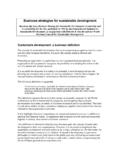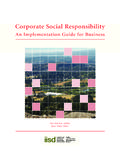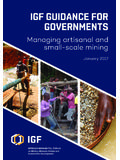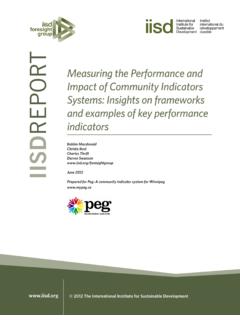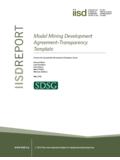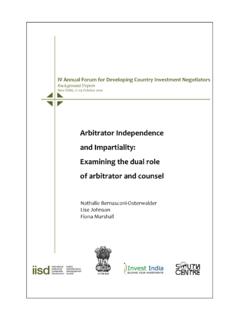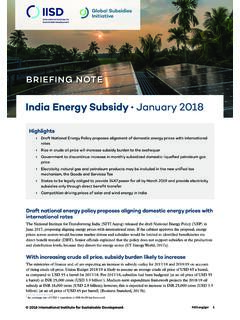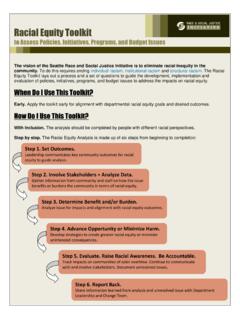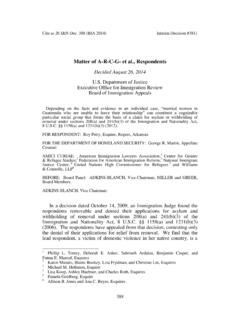Transcription of Social Impact Assessment (SIA)
1 Social Impact Assessment (SIA). A Social Impact Assessment is a process of research, planning and the management of Social change or consequences (positive and negative, intended and unintended) arising from policies, plans, developments and projects (UNEP, 2007). The core focus of an SIA is on the important impacts of projects and developments beyond the impacts on natural resources. Examples of Social impacts include (Vanclay, 2003): People's way of life that is, how they live, work, play and interact with one another on a day-to-day basis. Their culture that is, their shared beliefs, customs, values and language or dialect. Their community its cohesion, stability, character, services and facilities. Their political systems the extent to which people are able to participate in decisions that affect their lives, the level of democratization that is taking place, and the resources provided for this purpose.
2 Their health and well-being health is a state of complete physical, mental, Social and spiritual well-being and not merely the absence of disease or infirmity. From the listed examples above, it is clear that the SIA must look not only at Social issues but also at the environmental impacts and their interactions. For example, if the planned project impacts the availability of water and land for local food production it also leads to Social impacts, such as increases in food prices, the need to travel longer distances to buy and/or grow food. In general, an SIA calls for close collaboration with community members, as well as other stakeholders and experts. This usually covers the following specific areas to identify impacts and mitigation measures (State of Queensland, 2013): Community and stakeholder engagement Workforce management Housing and accommodation Local business and industry content Health and community well-being.
3 During the SIA, the proponent is usually expected to (State of Queensland, 2013): Identify stakeholders' groups and communities impacted by the project. Collect baseline data covering key Social issues of the impacted communities such as community history, indigenous communities, culture and key events that have shaped economic and Social development, key industries presently and in the past (if relevant);. pressures or vulnerabilities experienced by these industry sectors. Provide an overview of government legislation and policies that complement the mitigation measures for Social impacts that are directly related to the project. Explain methods used to gather information, including a description of how the communities of interest were engaged during the development of the SIA. Identify potential direct Social impacts and prediction of the significance of any impacts and duration and extent of each Impact .
4 1. List proposed mitigation measures. Describe the monitoring framework that informs stakeholders on the progress of implementing mitigation measures and overall project implementations. SIA Case study: Tourism (Tanzania). This case study summarizes parts of the developed EIA report by Zanzibar Environmental Consultancy (2006). Project: Zanzibar Beach Hotel and Resort Upgrade and Extension Location: Matemwe Village, North A district Unguja Island, Zanzibar, Tanzania Date: February, 2006. Zanzibar consists of two main islands approximately 30 km off the East African coast. The islands are part of the United Republic of Tanzania, but have their own independent government. Due to poor planning for tourism developments, the industry has suffered from inadequate infrastructure as well as environmental and Social degradation. To address these issues, in 1996, the Commission for Land and Environment of the Government of Zanzibar enacted an Environmental Management for Sustainable Development Act.
5 Project overview The assessments done for this project focus on the environmental and Social impacts that the upgrade to Zanzibar Beach Hotels and Resorts may have on the local area. The project is located close to the village of Matemwe, North A district , North Region of Unguja Island and is located on ha, with 450 m of beachfront property. The hotel is 50 km away from Zanzibar Stone Town and is accessible by road. The main natural resources in the area include government plantation reserves, dryland natural forest and mangrove reserves, coral rag thicket forests and rubber plantations. The government plantation reserves specialize in growing exotic trees such as teak, acacias, pine and casuarinas. The marine environment includes sea grass-algae beds, sandy habitats and coral reefs. The Environmental Impact Assessment (EIA) was developed using the terms of reference set out by the Department of Environment, Ministry of Agriculture, Livestock and Environment-Zanzibar in accordance with national laws.
6 The approach taken for the EIA and the SIA focused on public participation, ecosystems, sustainability and indigenous knowledge and will incorporate capacity development into the process. The main tools used to collect and analyze data were: A literature review to collect information about key current and past trends in the community on key industries, housing, livelihoods. A policy review relevant for Impact Assessment and Social impacts. A Participatory Rural Appraisal (PRA) with both quantitative and qualitative surveys using field investigations for specimen collection to get stakeholders' input and feedback on key impacts, mitigation actions and monitoring measures. Through the introduction of tourism into the area in the late 1990s the population of the area around the project has increased at a rate of about 5 per cent per year.
7 In 2002, the population of nearby, Matemwe was 2,429, up from 728 inhabitants in 1998. Estimates for 2010 place the population at 3,085. Housing in the area consists of either thatched huts with no window or plumbing or cement block houses with thatched roofs made from coconut leaves or iron sheets. Approximately 44 per cent of the houses have and use toilets, which helps with sanitation. 2. Social services There is one Primary Health Care Unit (PHCU) with six staff members. This unit along with a dispensary provides all general health services for the area. Common diseases include malaria, bronchitis, stomatitis, diarrhoea and dysentery. If seriously ill, individuals must travel outside the village to Kivunge Cottage Hospital or Zanzibar Town. The Zanzibar government recently achieved the goal of distributing educational facilities within a 5-km radius.
8 A public primary school is available in Matemwe where local children (as well as children from surrounding villages) attend classes. There are no middle schools in the immediate area. There are also five Quran schools available, four mosques and four Madrasa in the community. Local Economy Shops and restaurants are located in both Matemwe and Kiwengwa Shehia. Here one can purchase basic goods, school supplies and souvenirs. Major economic activities in the area include fishing, seaweed farming, agriculture, petty trade and animal husbandry. Unfortunately over the years, fish stocks have been declining despite a poor economy based around the resource. The fishers rely on a single port in Matemwe to access current fishing grounds. Seaweed farming is primarily done by women. This is laborious work and demands between five to seven hours each day to tend the seaweed plots.
9 Agriculture is also a very important part of the economy. It consists of cassava, mango, maize, sorghum and other annual crops that are grown for personal consumption, with a small portion being sold on the local market. Similarly, animals are raised for personal consumption only. Participatory Rural Appraisal surveys The PRA surveys found that while locals welcomed tourism in general, they felt that the increase in the industry did not match an increase in economic benefits to the area. The younger population wants to see more benefits distributed throughout the village, while the older generation wants to ensure that local customs, rules and regulation are followed. This includes the use of proper dress while tourists are off the hotel site. Culture is an important part of local life in the area. Most of the residents are part of the majority cultural group on the island; they speak Kiswahili and are primarily Muslim.
10 It was noted that the local Islamic Swahili group may be vulnerable to cultural pollution, especially the youth. Employment within the tourism industry was seen as unavailable to locals. While the industry was promoted as bringing in jobs, it was argued that most villagers were not skilled or experienced enough to fill intermediate and managerial positions. They argued, however, that many of the lower posts such as maintenance, cleaning and cooking should be reserved for locals instead of migrants from mainland Tanzania or Kenya. Spinoff income through trade and sale of products also seems minimal. There are few formal jobs available to local residents. Most work is informal, including hotel workers, carpenters, drivers, farmers, fishers and businessmen. Child labour is also an issue in the area. In some hotels in the area children engage in different activities.
